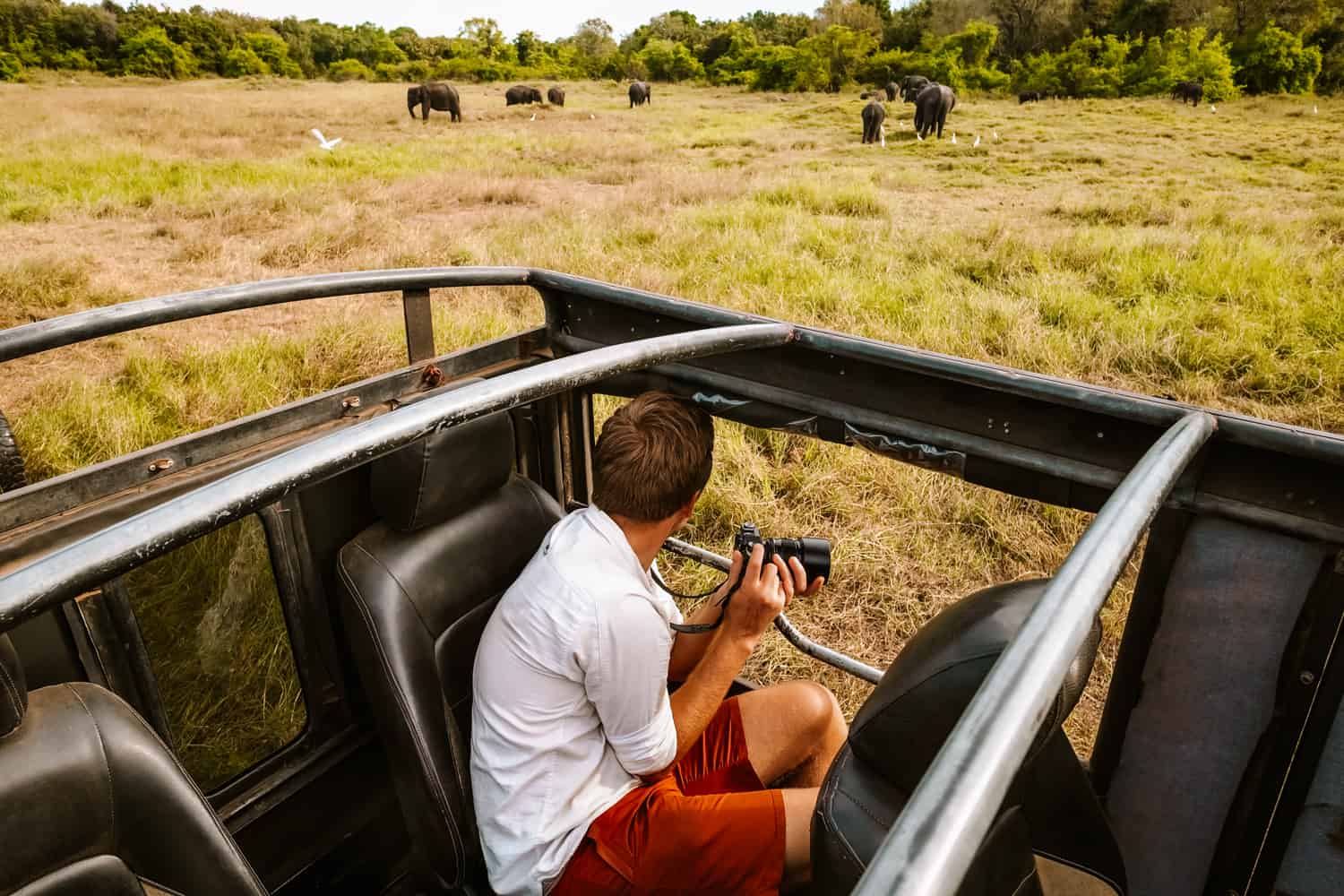The beautiful island of Sri Lanka is an absolute delight with so many different attractions to see. From cultural and historical sites to golden sandy beaches and amazing wildlife, there is so much to love about this picturesque island nation.
Although it is the diversity of experiences that makes Sri Lanka one of the best holiday destinations in the world, its wildlife alone is a good enough reason to visit Sri Lanka for a couple of days.
A significant portion of the wildlife in Sri Lanka is endemic to the country, while some, such as western reef egrets and Pacific Golden-Plover, migrate to the warmer climates of the country when it starts getting colder in their own home countries. Like everyone else, these birds seem to love the warm temperatures in Sri Lanka that are prevalent all year round.
Here are some of the exotic animals you will be able to enjoy while visiting this island nation and where to find them.
National parks in Sri Lanka
There is no better way to start this article than by giving a little overview of the national parks in Sri Lanka, as these are the places that you need to visit to explore its wildlife.
The island nation is home to 26 national parks, each offering a different experience to its visitors. For those looking for a thrilling jeep safari, the best national parks in Sri Lanka are Yala, Minneriya, Udawalawe, Wilpattu, Bundala, Kumana and Gal Oya. However, for a unique and immersive experience, the Horton Plains stands out as the only national park that can be explored on foot. In addition to these, Sri Lanka also boasts two marine national parks, Hikkaduwa and Pigeon Island, for those who want to explore the ocean and marine life of the country.
Generally, jeep safaris in Sri Lanka are recommended from 6.00 am to 9.00 am and 3.00 pm to 6.00 pm, when the animals are most active. The exceptions are Minneriya national park which is recommended only in the late afternoon, and the Udawalawe national park, which you can visit any time of the day to see animals. If you decide to hike the Horton Plains, be at the entrance by 6.00 am, as the recommended time for the Horton Plains is from 6.00 am to 9.00 am.
The exotic wildlife in Sri Lanka
The wildlife of Sri Lanka is highly diverse, including 125 mammals, 185 reptiles, 122 amphibians, 95 freshwater fish, and over 400 species of birds. It is unlikely that you will see all these animals within a 2 to 3-week holiday in Sri Lanka, but here are a few the animals not to miss.
1. The majestic Elephant
The majestic Sri Lankan elephant is one of the most beautiful in the world. These gentle giants have been an integral part of the country since ancient times, crucial to the royal entourage, religious festivals, and processions.
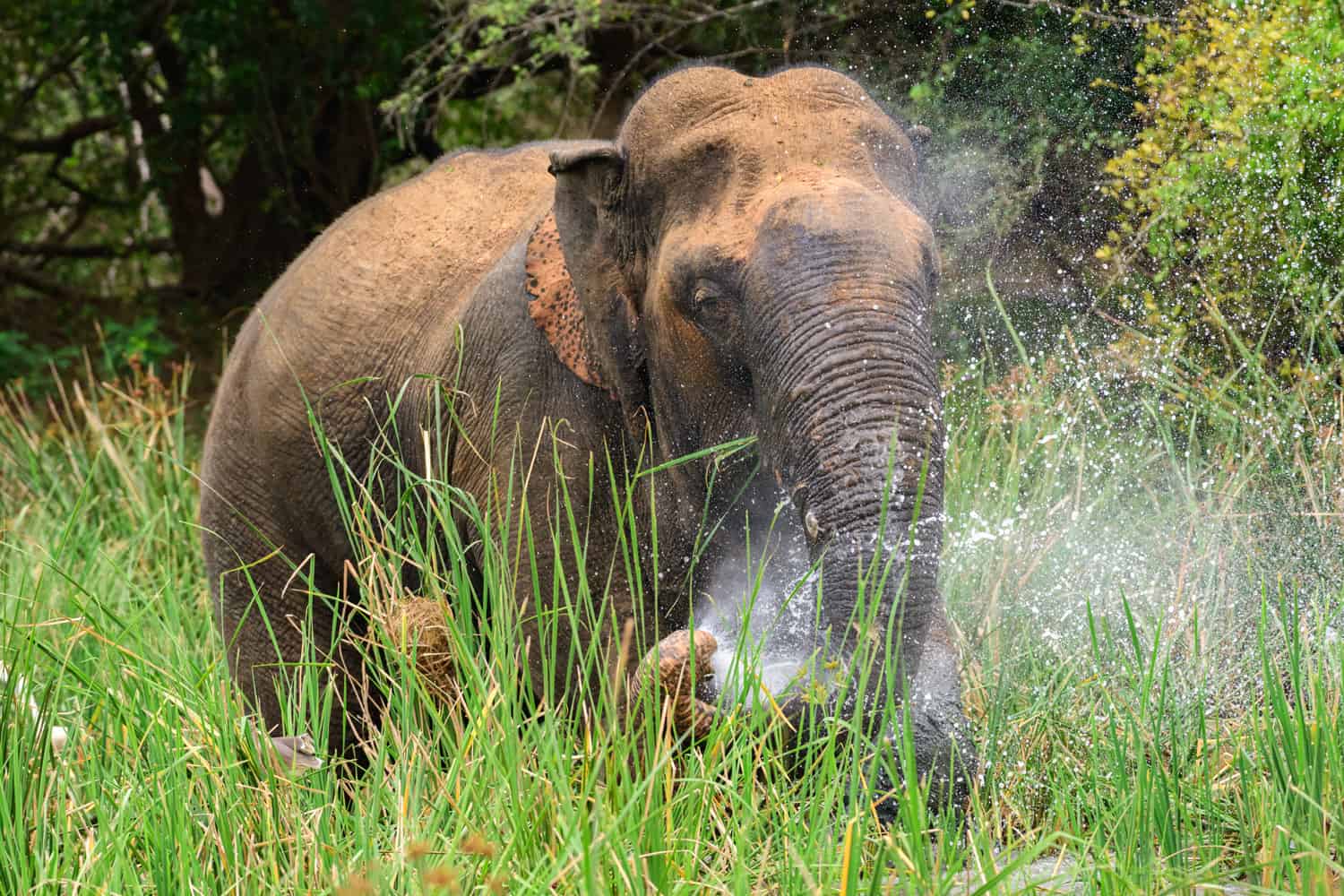
A herd of elephants, which includes the females and babies, is usually led by the alpha female (or the oldest female in the herd), while the males leave the pack once they are of a certain age, roaming the surrounding areas on their own. It is fascinating to note that when it comes to Sri Lankan elephants, only the males have beautiful ivory tusks, and not the females as in other subspecies of elephants around the world.
While herds of elephants can be found in almost all of the national parks in Sri Lanka, the best national parks to see elephants on the island are Minneriya and Udawalawe national parks.
One of the highlights for elephant lovers is the annual elephant gathering in Minneriya, which take place during its dry season, from July to October. When the potholes and other water sources dry up, the elephants come out of hiding and make their way to the Minneriya lake to quench their thirst, eat sweet young grass, and socialize with each other. This gathering of roughly 350 elephants is the largest of its kind, making it a truly awe-inspiring sight.
2. Fearless Sri Lankan Leopard
Sri Lanka boasts some of the world's most stunning leopards, known as Panthera Pardus Kotiya. Their striking spots and mesmerizing gaze will leave you in awe if you are lucky enough to spot one during a jeep safari.
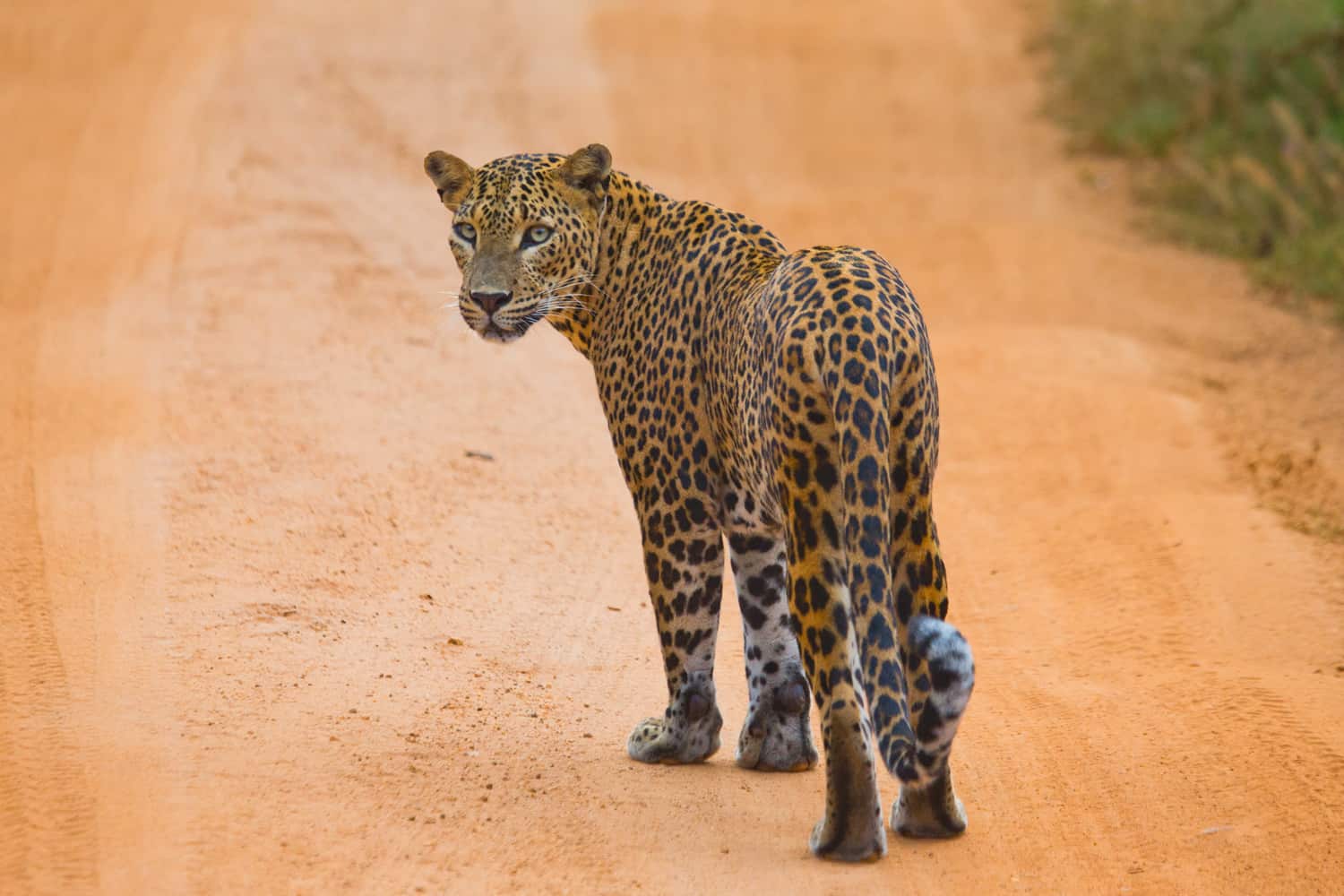
One of the best places to see these majestic creatures is at the Yala National Park in the southern region of the country. The best time to go on a safari in Yala National Park in search of leopards is early morning when the leopards are most active. Some tour operators also offer full-day safaris for those who want to have a better chance of seeing and photographing these elusive cats. Another location to spot leopards is the Wilpattu National Park, but sightings are not as frequent as in Yala.
Sadly, the leopard is an endangered species in Sri Lanka, with the numbers declining over the past few years. However, many government and private organizations are working hard towards leopard conservation, trying to make a difference in the diminishing numbers of these beautiful and elusive cats.

Would you like a Sri Lanka trip like Beatriz's?
We had the pleasure of assisting Beatriz's family on their two-week holiday in Sri Lanka, and they absolutely loved it. Would you also like a hassle-free family holiday? Please drop us a message specifying your requirements, and we will get back to you with a tailor-made Sri Lanka tour package within 24 hours.

Would you like a Sri Lanka trip like Beatriz's?
We had the pleasure of assisting Beatriz's family on their two-week holiday in Sri Lanka, and they absolutely loved it. Would you also like a hassle-free family holiday? Please drop us a message specifying your requirements, and we will get back to you with a tailor-made Sri Lanka tour package within 24 hours.
3. The marine wildlife; Blue Whales
If you love the gentle giants of the land, then you will surely love these gentle giants of the sea! The country is situated along a migration route used by several species of whales and dolphins, making it an ideal spot to witness these magnificent creatures in their natural habitat.
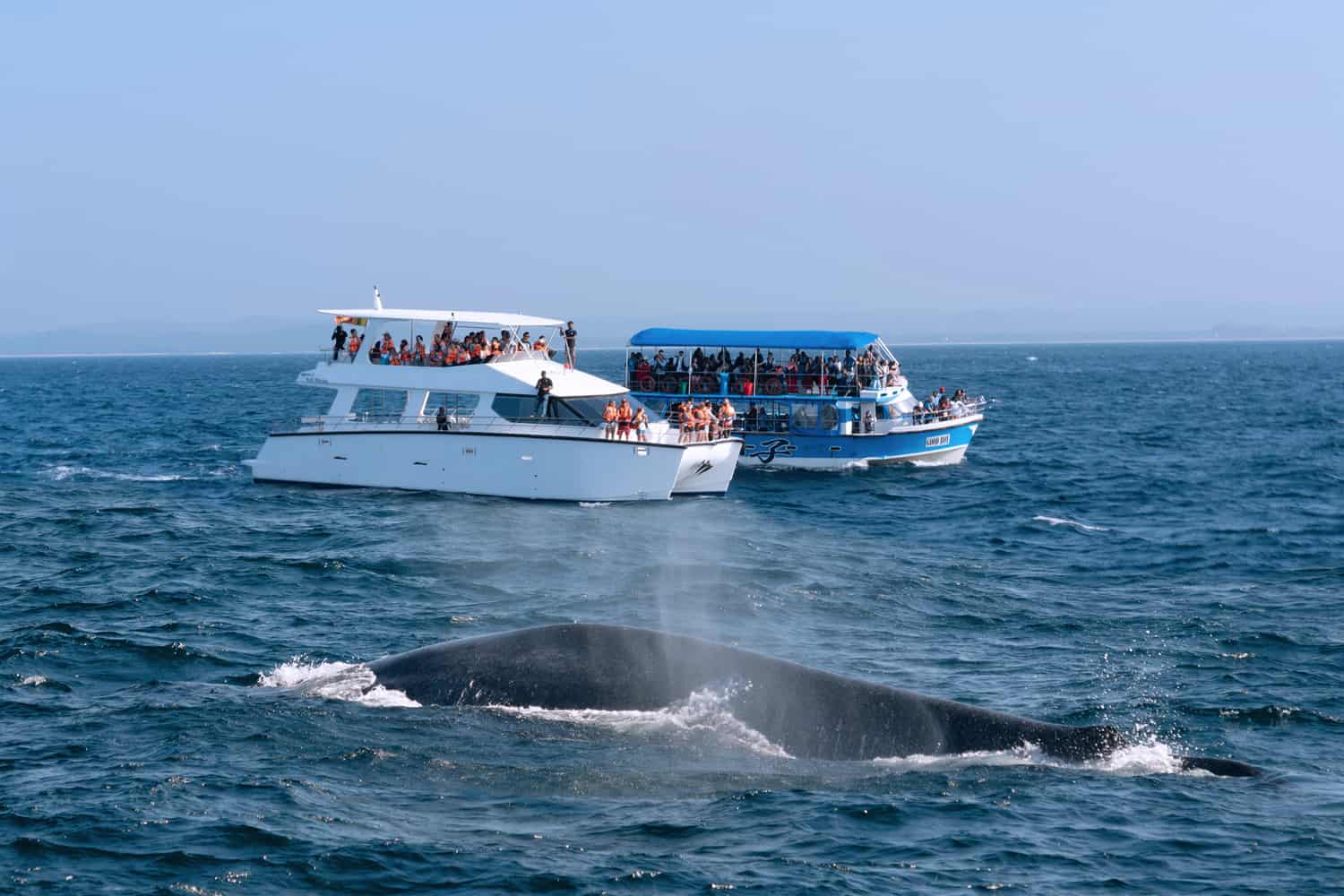
One of the best places to go whale watching in Sri Lanka is the southern coastal town of Mirissa. The deep waters off the coast of Mirissa attract a variety of whale species, including the majestic blue whale, which is considered the largest animal on earth.
Visitors can take a boat tour from the Mirissa harbour and have the chance to see these giants up close. The whale watching season in Mirissa is from November to April. Keep in mind a typical whale-watching tour starts around 6.00 am and lasts about 5 hours. This is not an excursion for the impatient.
4. The elusive Sloth Bear
Sloth bears are elusive shy creatures. They are among the most ferocious of bears found anywhere in the world, however if you come across one of these cute creatures while travelling in Yala or Wilpattu National Parks, do not fear; they have never been known to show any type of aggression towards travellers or their vehicles. Although known to be shy, they are not beyond providing you with some entertainment with a few antics of their own, as they relax and unwind along the roadside or roll around in the dust to keep cool.
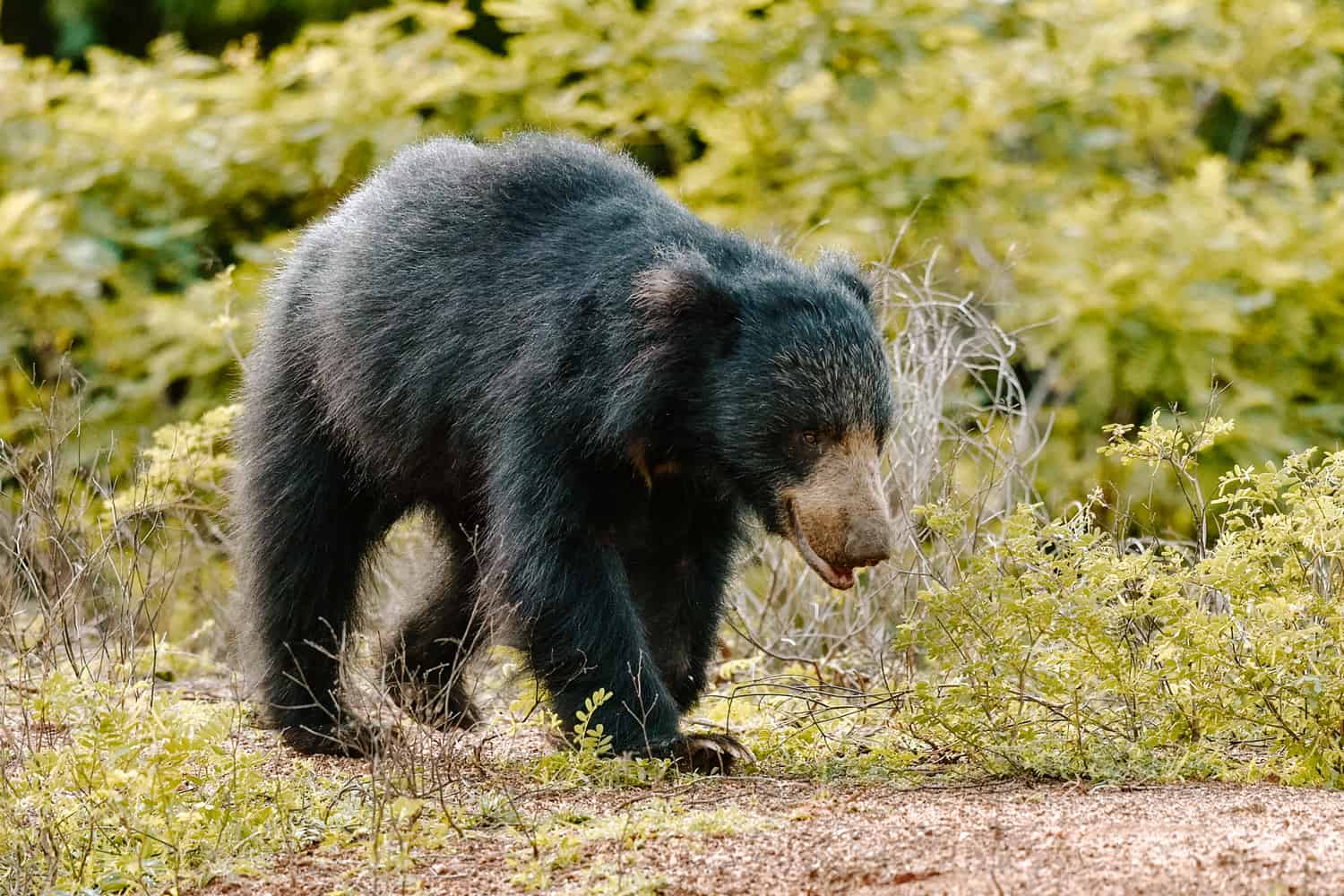
One of the best times to visit the parks if you want to see sloth bears is in the early morning. This is because the bears are nocturnal animals that prefer to walk around looking for food and water before the sun fully rises or during dusk, when the climate is not too hot for them. During moderately rainy seasons and during the months when berries and fruits fill the tress, you will be able to see them as they forage around for tasty delicacies. If there are no berries around, they prefer to try their luck with an anthill, where they can get some much-needed nutrition.
These bears prefer to live where there is dense forestation and rocky caves where they can spend the day when the sun gets too hot. Most safari guides will be able to locate these bears easily if they are nearby, because they grunt and make noises as they travel, which is said to be a form of communication between them.
5. The Sri Lankan Sambar Deer
The Sri Lankan sambar deer are gentle creatures found roaming around the hillsides of Horton Plains and other colder areas of the country. They are quite heavy and have thick brown fur to ward off the cold, and beautiful antlers that reach to the heavens, although it is only the males who grow antlers.
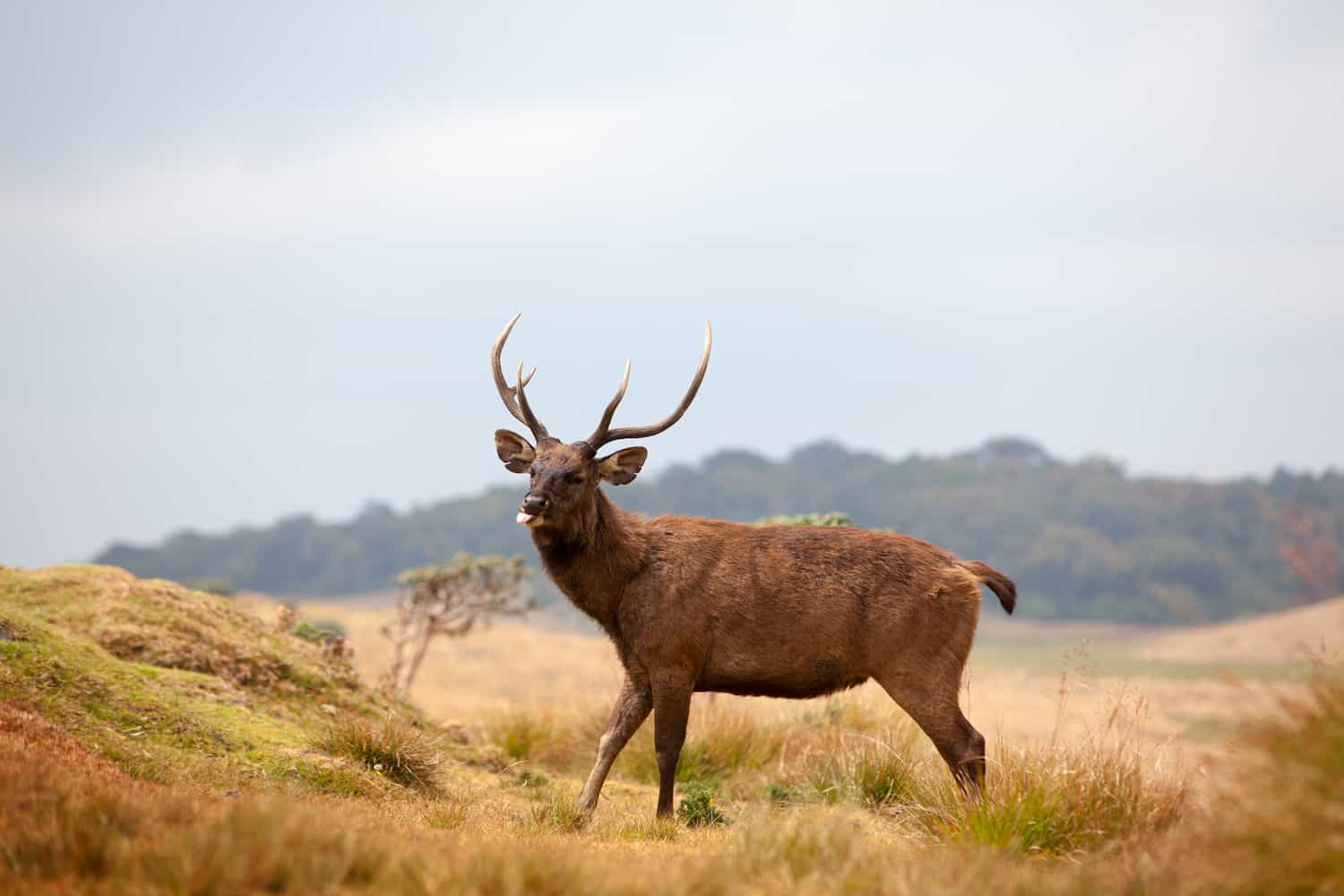
These deer can be seen all year round when travelling towards Horton Plains and within the plains themselves. A few have even become domiciled along the roadside, where they have got used to eating fresh fruits such as bananas from passers-by and even the wildlife guides. The best times to see them are in the early morning and late evening when they come out of hiding to forage. At other times, they stay away from the hot sun, preferring to lie under a shady tree until the sun goes down and it is time for a snack.
If you time your tour precisely, you will be able to photograph them in herds and may even be lucky enough to get a few close-ups.
6. Sea Turtles of Sri Lanka
Many species of sea turtles visit the shores of Sri Lanka to lay eggs. These include leatherback turtles, hawksbill turtles, the green turtle, olive ridley and the loggerhead. It is only female sea turtles who ever come ashore, and this too only for the purpose of laying eggs; the males live their life out in the sea. The turtles in the turtle beach of Hikkaduwa are an exception. They come to the shore daily to be fed seaweed by the tourists.

It is no secret that the number of sea turtles is declining fast with increasing ocean pollution. This is why so much conservation work is being done, from saving sea turtle eggs to rescuing injured or hurt turtles.
Along the southern coastline of Sri Lanka ( especially in the Kosgoda area), you will see many turtle conservation projects endeavouring to save these beautiful creatures. These conservation sites rescue sea turtle eggs from predators, both human and animal, giving the species a chance to survive. During the evenings, you can even participate in releasing a few baby turtles into the ocean; however, remember that these lovely aquatic animals need to be handled very gently and carefully.
7. Amazing Crocodiles
If you are into exotic wildlife, you will surely love the snapping crocodiles of Sri Lanka! This island is home to two species of crocodiles; the marsh crocodile and the saltwater crocodile.
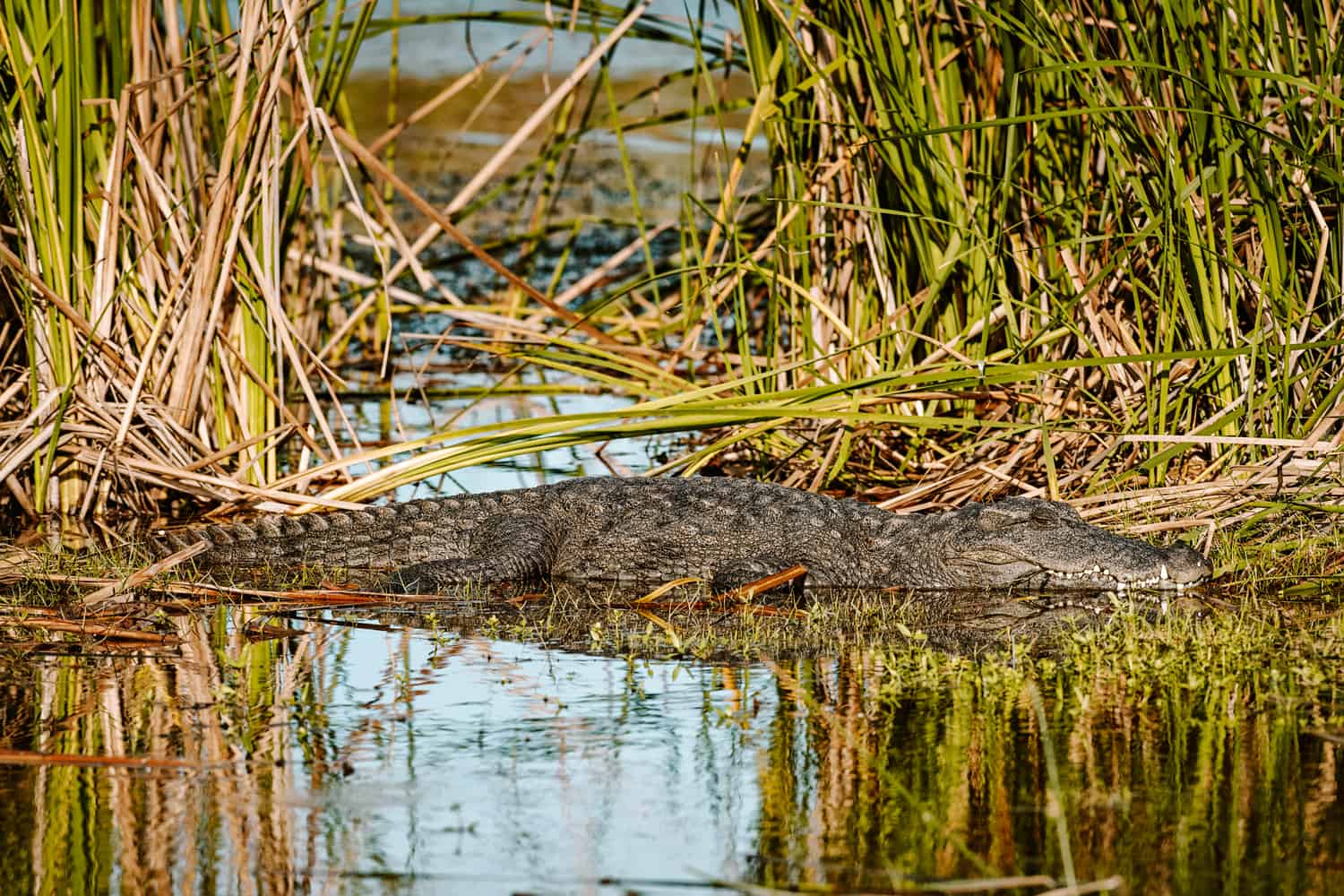
Both are predatory animals, and marsh crocs love to sunbathe in the hot sun during the dry season, which is the best time to visit the national parks in Yala and Udawalawe, where they are commonly found. During the rainy season, they are a little harder to spot, as they stay underwater most of the time due to rising water levels.
The Kumana National Park is another place where you can easily spot a few sunbathing crocs as you travel through it, photographing the birds and other assorted animals. The marshy land prevalent in this area is ideal for them to prey on many small to medium animals for food. Remember to take out your cameras because these crocs love to pose for a few photos as they enjoy the sun.
Note: The dry season in Udawalawe, Yala and Kumana is from January to September. However, Yala national park is closed in September.
8. Sri Lankan Wild Boar
Wild boars, also known as Sus scrofa, are an integral part of the wildlife in Sri Lanka. According to folklore, the wild boar is the vehicle of Mahasona, who is the chief of all demons.
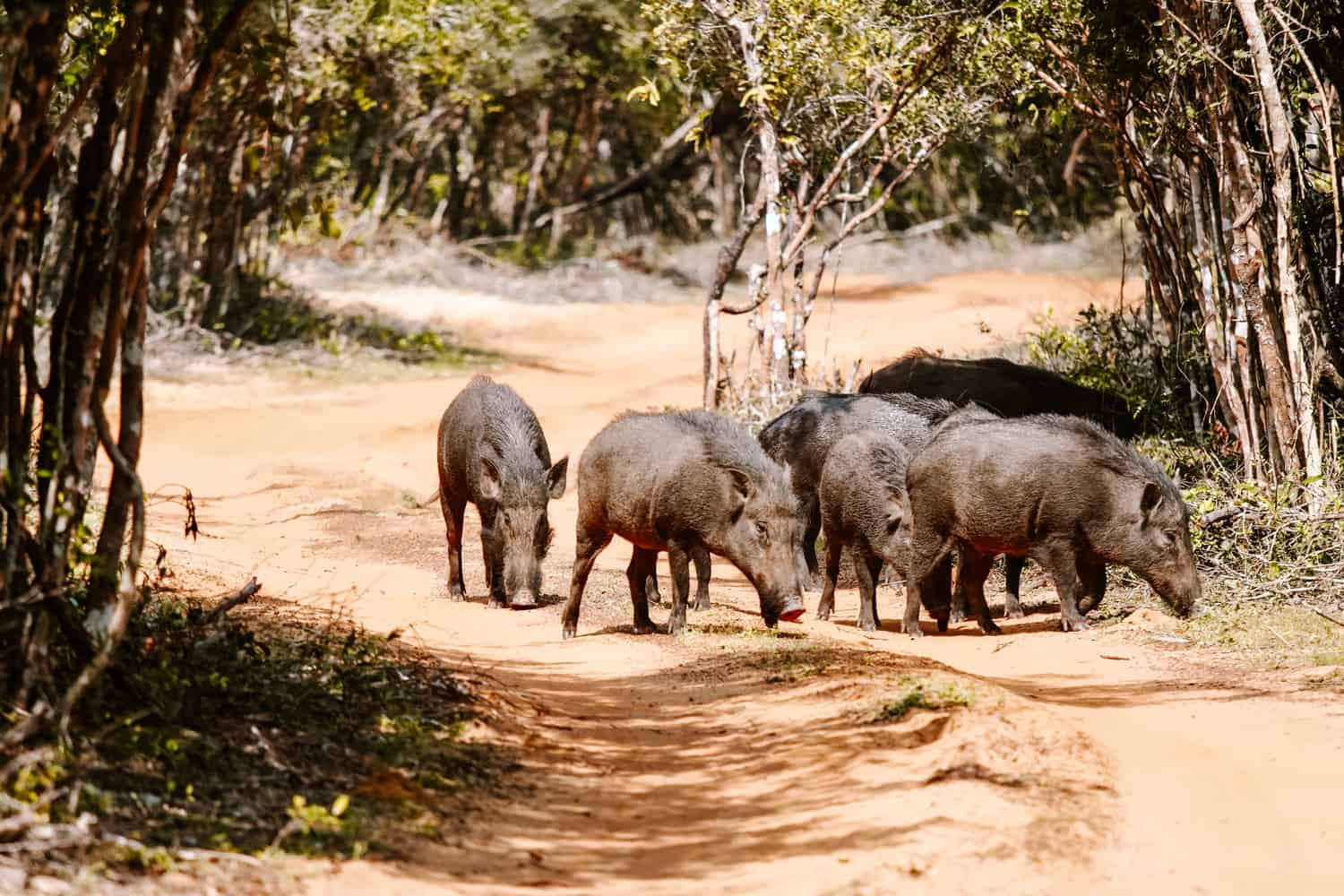
In Sri Lanka, wild boars are typically found in forests and scrublands. If you visit the Yala National Park, you will surely see these greyish-brown creatures with small but dangerous tusks roaming around in packs of 10 to 15.
They are known to be omnivores, feeding on a wide range of plant and animal matter, including roots, fruits, insects, small mammals, and reptiles. They are also known to be opportunistic feeders, which means they will eat whatever is available to them. Farmers are not very fond of them as they are known culprits for destroying crops.
Like other animals, if you want to see them, they are more active in the early mornings and late evenings when the heat is minimal. During the day, they prefer to lie down in the shades and rest until the sun is set.
9. Beautiful birds of Sri Lanka
If you enjoy bird watching, you are up for a treat. Sri Lanka boasts 492 bird species, which include 34 endemic and 219 breeding residents.
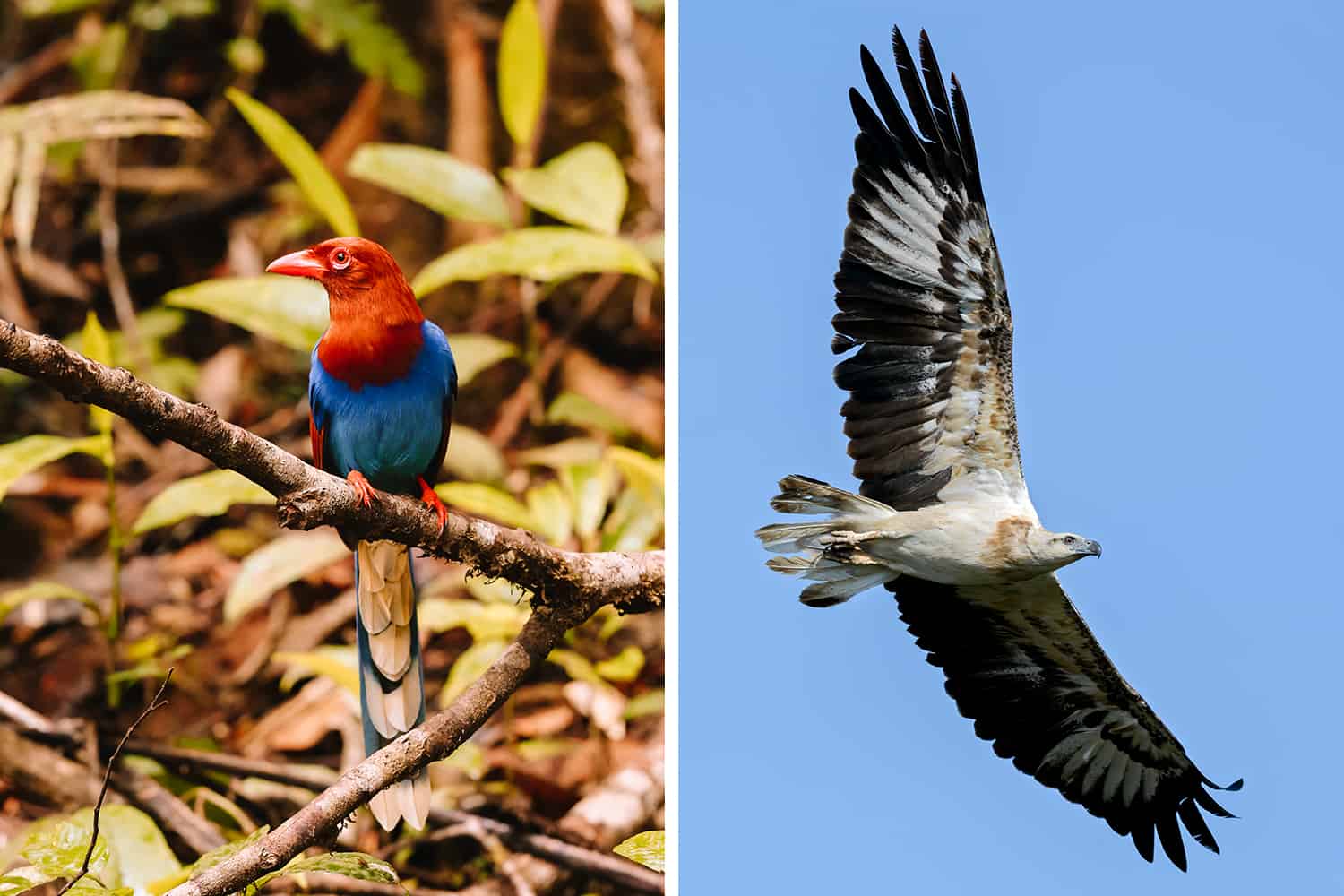
In any national park in Sri Lanka, you can spot some birdlife, but Kumana is the go-to place for bird watching in Sri Lanka. It is located in the Eastern Province, bordering Yala, and is home to around 255 species of birds. There is no specific season to visit the park if you want to see exotic birds, as they are there all year round. The best times of the day to visit the Kumana National Parks are either early in the morning or late afternoon. One cannot guarantee which type of birds you may see, but you will surely see some exotic and colourful ones, from Malabar trogon to glossy ibis and black-crowned night herons to lesser whistling ducks.
The Bundala National Park in the Hambantota District, along the southern region of Sri Lanka, is another hotspot for bird watching, with the recorded number of birds reaching 197. One of the most popular bird varieties to see here is Flamingos, which migrate to Bundala in large flocks. Pelicans, egrets, and different species of ducks are quite common in this park.
While Kumana and Bundala are the places to see birds of all different varieties on a jeep safari, you can also visit the Kalametiya Bird Sanctuary to enjoy some exotic birds on a boat ride.
10. The cheeky Toque Macaque
The Toque Macaque, or the “Rilawa” as in Sinhalese, is a species of primate native to Sri Lanka. Wherever you go in Sri Lanka, whether it is in the dry zone, wet zone or hill country, you will be able to see these macaques sitting atop trees, running along the electrical wires or simply sitting at the side of the road watching you intently. Be careful of waving food items around them. These beautiful creatures have a reputation for thievery.
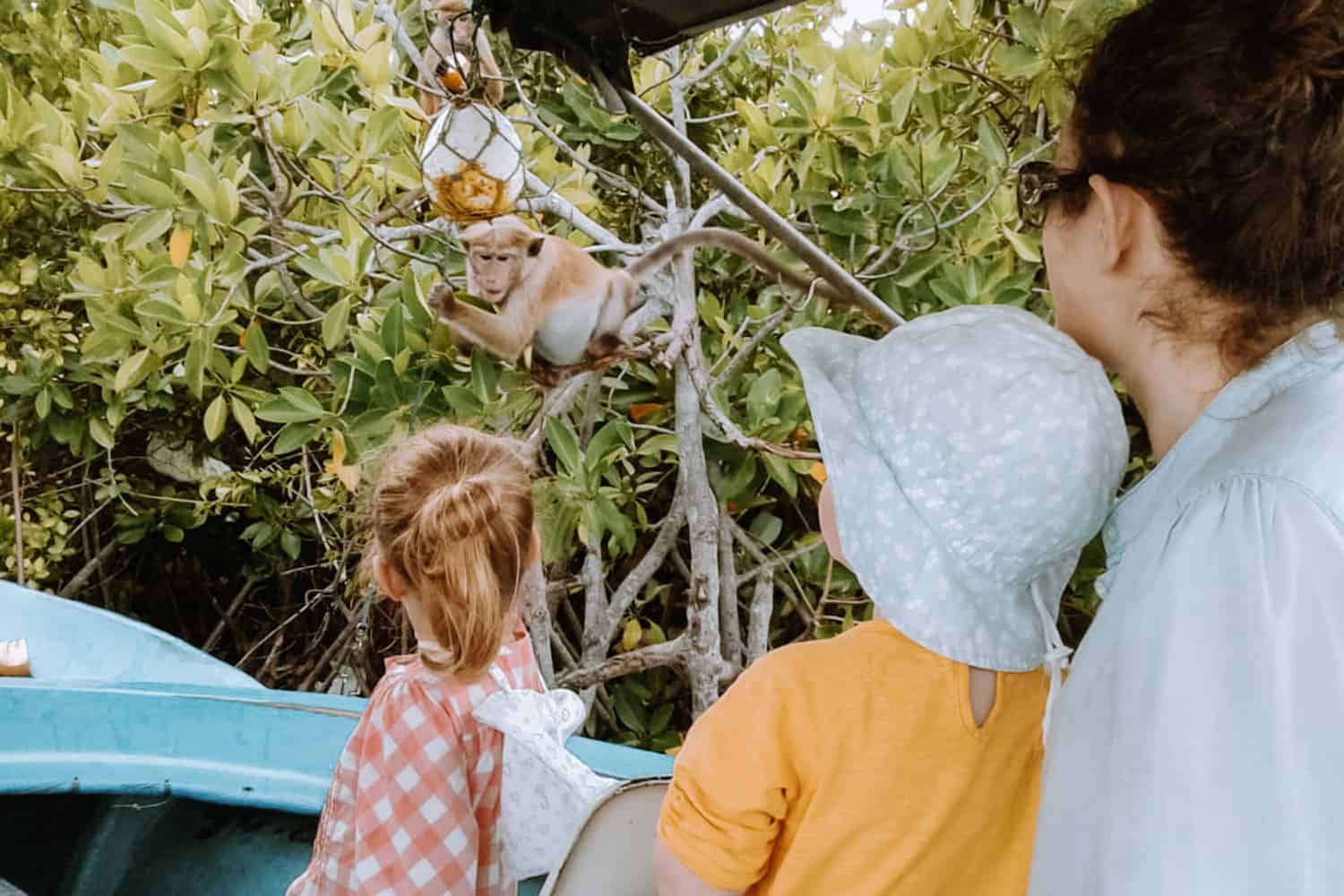
If you are wondering how to recognize them from a standard monkey, it is very easy. They have a cheeky look on their faces and an unkept mop-top of a hairdo! They are of course gorgeous creatures to photograph, and their social aspects can be very similar to humans.
Small children adore Toque Macaques but do not let them pet them or feed them. We have had incidents where guests got scratched by them as they tried to interact, and they had to stop everything and go to the nearest hospital to get vaccinated for rabies.
Summary
Sri Lanka is a biodiversity hotspot known for its diverse wildlife. The island nation is home to a wide range of animals, including elephants, leopards, birds, and a variety of primates. It is fair to say the country's wildlife is both diverse and exciting.
I hope this week's Travellers Isle article helps you in your adventure through the dense forests of Sri Lanka, finding its majestic elephant, fearless leopard and the blue magpie. Feel free to leave a comment if you have any questions or drop us a message if you would like our assistance in organizing your Sri Lanka trip. We at Travellers Isle are looking forward to hearing from you.
Happy travels!

